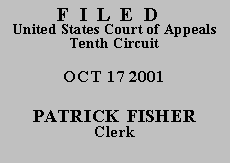

|
UNITED STATES OF AMERICA, |
|
Before HENRY, BRISCOE, and MURPHY, Circuit
Judges.
Appellant Ewing Hirata Vise pleaded guilty to drug and firearm charges. Vise challenges his sentencing under the United States Sentencing Guidelines on the ground that Apprendi v. New Jersey requires all facts relevant to sentencing under the guidelines be submitted to a jury and proved beyond a reasonable doubt. Because a panel of this court has already rejected the applicability of Apprendi to the Sentencing Guidelines, we affirm the sentence.
II. FACTS
Ewing Hirata Vise pleaded guilty to manufacturing methamphetamine, in violation of 21 U.S.C. § 841(a)(1) and 18 U.S.C. § 2, and possession of a firearm as a felon, in violation of 18 U.S.C. § 922(g)(1). On the drug count, he was given a life sentence under the mandatory sentencing provisions of 21 U.S.C. § 841(b), in part based on the quantity of drugs involved in prior drug convictions. Mr. Vise received a concurrent ten year sentence on the firearm count.
Vise appealed the sentence. During the pendency of the appeal, this court decided in United States v. Santos that the mandatory sentencing provisions of 21 U.S.C. § 841(b) apply only by consideration of the drug amount for the current conviction, not "relevant conduct" drug quantities. 195 F.3d 549 (10th Cir. 1999). Vise's drug sentence was vacated and the case remanded to the district court for resentencing. United States v. Vise, 211 F.3d 1279, 2000 WL 485174 (10th Cir. 2000) (unpublished).
Just after remand, the United States Supreme Court issued its opinion in Apprendi v. New Jersey, 120 S.Ct. 2348 (2000). Apprendi held that "any fact which increases the penalty for a crime beyond the prescribed statutory maximum must be submitted to the jury, and proved beyond a reasonable doubt." 120 S.Ct. at 2362. The district court ordered briefing on the impact of Apprendi on Vise's sentencing. Vise did not provide the district court with briefing.
The district court resentenced Vise. The guideline sentence range was 155-188 months. Vise received 188 months in prison and 6 years supervised release on the drug charge.
Vise contends that Apprendi requires that any factor which increases his guideline sentence range be alleged in the indictment, submitted to the jury, and proved beyond a reasonable doubt.
III. DISCUSSION
Vise did not present this argument to the district court. Normally, failing to make below a specific objection to sentencing precludes appellate review. United States v. Gilkey, 118 F.3d 702, 704 (10th Cir. 1997). Because, however, the applicability of Apprendi to the sentencing guidelines is "'a legal question involving application'" of the guidelines, we review the sentence for plain error. Id. (quoting United States v. Ciaponi, 77 F.3d 1247, 1252 (10th Cir. 1996)).
In United States v. Sullivan, this court held that Apprendi "does not apply to sentencing factors that increase a defendant's guideline range but do not increase the statutory maximum." 255 F.3d 1256, 1265 (10th Cir. 2001). Vise concedes that Sullivan is dispositive, but wishes to raise the question of the applicability of Apprendi to preserve the issue for appeal to the United States Supreme Court. This panel can not overrule circuit precedent. Berry v. Stevinson Chevrolet, 74 F.3d 980, 985 (10th Cir. 1996). Accordingly, the sentence was not in error.
The sentence imposed by the United States District Court for the Western District of Oklahoma is AFFIRMED.
ENTERED FOR THE COURT
Michael R. Murphy
Circuit Judge
*. This order and judgment is not binding precedent, except under the doctrines of law of the case, res judicata and collateral estoppel. The court generally disfavors the citation of orders and judgments; nevertheless, an order and judgment may be cited under the terms and conditions of 10th Cir. R. 36.3.